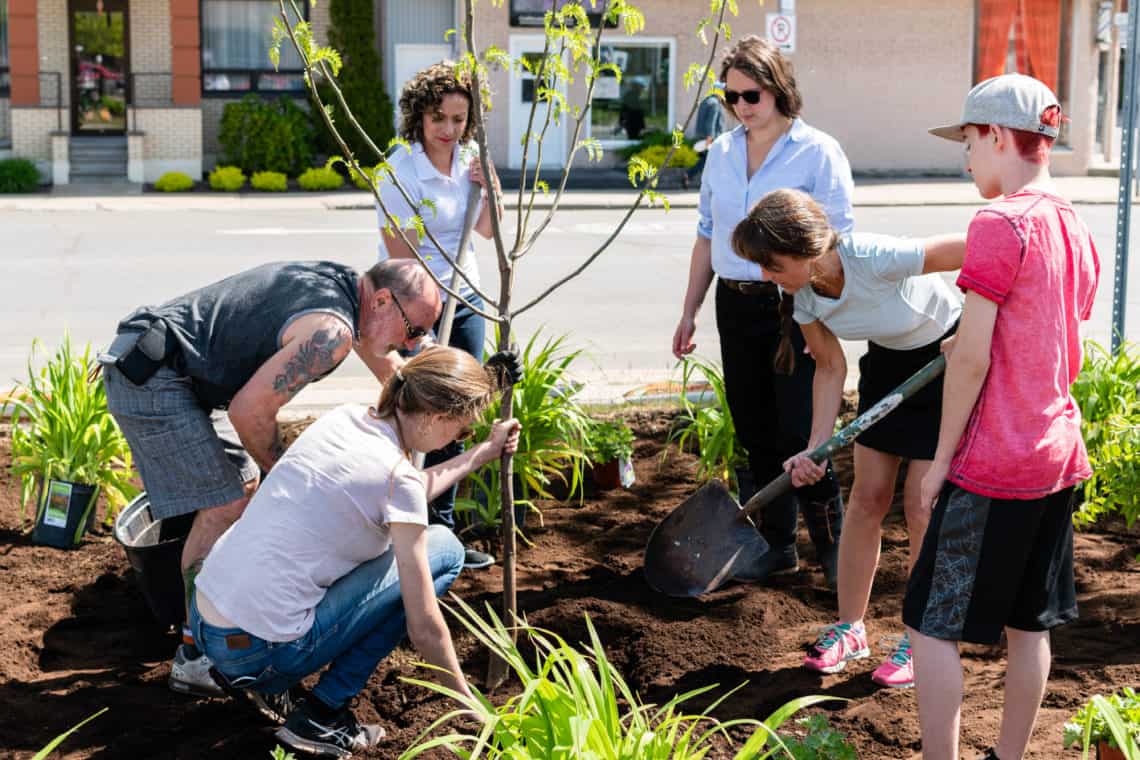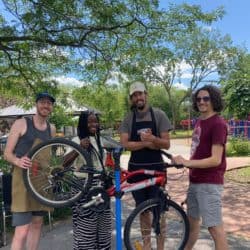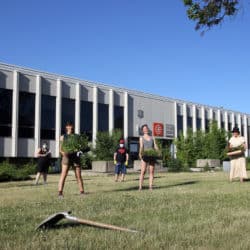Cities have developed at the expense of the human condition, and Centre d’écologie urbaine de Montréal wants to change that. The organization’s aim is to develop the capacity of individuals and communities across Quebec to work together to create democratic, healthy, resilient cities on a human scale.
Non-profits tackle big problems: poverty; inequities in health, education, and work access; sexual and racial discrimination; refugee crises; food insecurity; community development; et cetera. But a cross-cutting challenge calls for their contribution at another level: the climate crisis. In our Mission Transition series, contributor Diane Bérard examines why non-profits and civil society groups should make the socio-ecological transition a core driver of their strategy, how to do it, and how funders can help. She spoke with seven organizations with very different missions, all contributing to the transition in their own way.
Resilience is essential to the adaptive part of the transition. In our second Mission Transition profile, we look at the Centre d’écologie urbaine de Montréal, whose aim is to develop the capacity of individuals and communities across Quebec to work together to create democratic, healthy, resilient cities on a human scale.
Centre d’écologie urbaine de Montréal (Montreal, with projects all across Quebec and partnerships throughout Canada)
Véronique Fournier, executive director
Mission: to build resilient cities through community engagement
What is the mission of the Centre d’écologie urbaine de Montréal?
We develop citizens’ power to act and increase the capacity of communities to work together to create cities on a human scale. We propose practices and policies to create ecological, democratic, and healthy cities. Launched 25 years ago, we deployed our first initiatives when society barely grasped the environmental challenge. Then, nature was considered a “rural thing”; it was essential to protect Canada’s wide-open spaces. Today, with 80% of Canadians living in cities, we realize that green spaces are also a “city thing.”
Is your action limited to Montreal?
No, we started in Montreal, but our projects occur all across Quebec. And we have had some partnerships with organizations in other provinces.

What is your definition of transition?
For many years, cities have developed at the expense of the human condition. The fact that people die during heat waves illustrates why cities are not viable as they were planned. It is time for urban planning to consider citizens; we deserve healthy and regenerative living spaces. Preserving canopy, maintaining biodiversity, managing stormwater, and limiting asphalt are all part of the solution. But the transition is not only a physical issue. The climate crisis disproportionately impacts certain groups; therefore, the transition is social.
How would you describe stakeholders’ contribution to the transition?
Citizens have the living expertise, professionals have the knowledge, and governments have the power of regulation.
How does the Centre d’écologie urbaine de Montréal contribute to the transition?
Our contribution covers a broad spectrum. We activate public debate by naming the issues and by proposing solutions. All our interventions focus on the link between climate and communities. You can’t tackle environmental problems without considering humans, and vice versa.
We also contribute to knowledge creation. For instance, we collaborated with Toronto and Calgary universities to research pedestrian security. The question was: are there more pedestrian accidents in poor neighbourhoods? We also contributed to research on a governance structure for transition projects. At the moment, we collaborate with a group of universities studying best practices for stormwater management.
Sous les pavés is one of your flagship projects. What is it about?
It is a demineralization initiative – citizens strip asphalt to reclaim green spaces. During Phase 1, more than 35 projects have been completed in 15 Quebec regions over five years. This spring, we launched Phase 2: all cohort members have been selected. We will back these groups with financing and training, with TD Bank as our partner. Sous les pavés trains the trainers. Non-profits identify sites that would benefit from demineralization and contact us for help. Once they gain the knowledge to proceed, they appeal to citizens. Citizens must do the job. Sous les pavés is a climate adaptation initiative: green spaces retain stormwater, asphalt doesn’t. A climate adaptation project contributes to non-profits’ and citizens’ transition learning curve.
Can you share a few examples of Sous les pavés projects?
In 2019, 100 square metres of asphalt was stripped from Shawinigan Public Market parking. The project mobilized 49 volunteers. In addition, grass and fruit trees were planted, creating a relaxation area for locals and visitors. The result: 212 cubic metres of water diverted from sewers and 54 kilograms of pollutants diverted from waterways. This summer, Environnement Mauricie, the non-profit that led the Public Market project, will supervise the demineralization of a schoolyard in Trois-Rivières.
In September 2021, more than 20 volunteers stripped 90 square metres of asphalt from the Granby Alzheimer Society’s parking. Their work led to the creation of a small park for all citizens.
Since August 2018, in Gatineau, residents of Le Gîte Ami, a shelter for people facing difficulties related to social exclusion and homelessness, gained a 90-square-metre island of freshness.

Most of these projects are led by non-profits. However, there are also private initiatives. Can you share one of those stories?
When Resolute Forest Products downsized its activities in Gatineau, it needed less parking space. The company ceded the land to Les Serres urbaines Notre-Dame (Notre Dame Urban Greenhouses). This social economy company revives the neighbourhood’s food circuit to move toward a local system. Resolute parking was transformed into community gardens with the contribution of Resolute’s employees. This project was not only about food security; it was also about climate adaptation. In 2017 and 2019, significant floods hit Gatineau’s region. Greening Resolute’s parking increases the community’s resilience to floods.
Your non-profit contributed to a 10-year project on transportation with the cities of Toronto and Calgary. What was the intent?
Our partnership is called Active Neighbourhoods Canada. It includes the Centre for Active Transportation (Toronto), Sustainable Calgary, and us. Together we developed and shared innovative approaches to co-designing active neighbourhoods. We worked with 20 communities to build settings that support walking, cycling, and other means of active transportation for everyone, by providing safe and welcoming urban design. The process included assessing particular issues and proposing targeted solutions. The long-term output of this collaboration is a toolkit for urban participatory design. We explain healthy public policies and how to influence them; citizen survey models are offered. You can also find information about road safety for vulnerable users and transforming streets to allow active play.
How are you financed?
We receive grants for our different projects. And we act as a social enterprise with municipalities; they hire us to develop and manage their participatory initiatives. For example, in 2021, we enforced the LaSalle borough’s first participatory budget. As a result, LaSalle decided to dedicate its $150,000 surplus to citizens’ initiatives. Le Centre d’écologie urbaine educated the population on the participatory budget; supervised the creation of a steering committee with citizens, professionals, and politicians; encouraged participation; and evaluated the process. Among the 94 projects proposed for improving LaSalle’s quality of life, three were selected by vote, and 818 citizens contributed.
What role do you see for the philanthropic sector in the transition?
The foundations working to alleviate poverty are the first concerned because the climate crisis accentuates inequalities. All adaptation initiatives associated with the transition take a toll on vulnerable people’s daily lives. Philanthropy can also help vulnerable communities hire full-time employees to facilitate mobilization and action. There is so much that volunteers can do. And last but not least, the transition implies a massive paradigm shift. A solid narrative has to be developed. Foundations can contribute. Philanthropy is comfortable funding projects that support democracy in the United States; not in Canada yet. Here are a few examples of initiatives supporting democracy: a group of students meeting representatives of local government, a study of the impacts of participatory budgets, a network of cities implementing various participatory initiatives, classes on project management, and governments programs. As you can see, the spectrum is broad and the possibilities endless!
***
Read more in the Mission Transition series.

